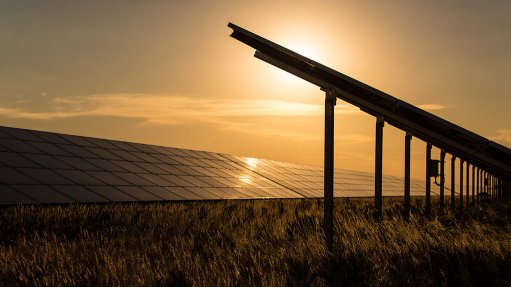
The Droogfontein solar PV plant near Kimberley
A South African solar energy atlas is in the process of being developed to further stimulate the deployment of both solar photovoltaic (PV) and solar thermal technology solutions in the sun-rich country.
Science and Technology Deputy Minister Michael Masutha reported this week that the South African Weather Services was in the process of establishing 12 solar radiation stations across the country, with six already operational.
Information collected from these stations, together with data gathered from private stations and satellite data collected by the South African National Space Agency would be used to compile the atlas.
Under the current Integrated Resource Plan, which was being updated, government envisaged that about 9 400 MW of new solar capacity be introduced into South Africa’s energy mix by 2030. About 8 400 MW was expected to be derived from solar PV power plants and about 1 200 MW from concentrated solar power (CSP) plants.
Following three competitive bidding rounds under South Africa’s Renewable Energy Independent Power Producer Procurement Programme, 64 projects had been selected, of which 33 were solar PV and three CSP projects. A number of the first bid window projects have entered into commercial operations.
Speaking at the opening of the R1.5-billion, 50 MW Droogfontein solar PV plant, near Kimberley, Masutha indicated that government still expected 5 000 MW to be deployed in a ‘Solar Corridor’ from Upington to De Aar, in the sun-drenched Northern Cape province.
“The atlas initiative will benefit the country by quantifying the solar-energy potential in the country,” Masutha, a well-known activist for the blind prior to his appointment, said from a speech delivered from a Braille text.
The information would be used to inform spatial distribution of solar energy farms, including future independent power producers. It would also enable the weather service to provide credible data to international bodies such as the Baseline Surface Radiation Network, a project of the World Climate Research Programme and the Global Energy and Water Cycle Experiment.
Besides the solar resource mapping exercise, the Department of Science and Technology had also collaborated with the Department of Energy, the Department of Trade and Industry and the International Energy Agency on a solar technology roadmap process, which had indicated that solar energy could be a significant future contributor to the Southern African energy mix.
It was also offering funding support to a range of institutions of higher learning to support research and development in both the areas of solar PV and CSP.
“The photovoltaic technology value chain has been analysed and, despite the fierce price competition in solar photovoltaic, there is belief that South Africa could still play a role in more strategic parts of the value chain.”
Areas of focus included exploring late-generation PV technologies and opening opportunities to use and beneficiate natural resources, such as silicon.
In CSP, the focus was on the development of systems ranging from components to plants, including hardware and software.